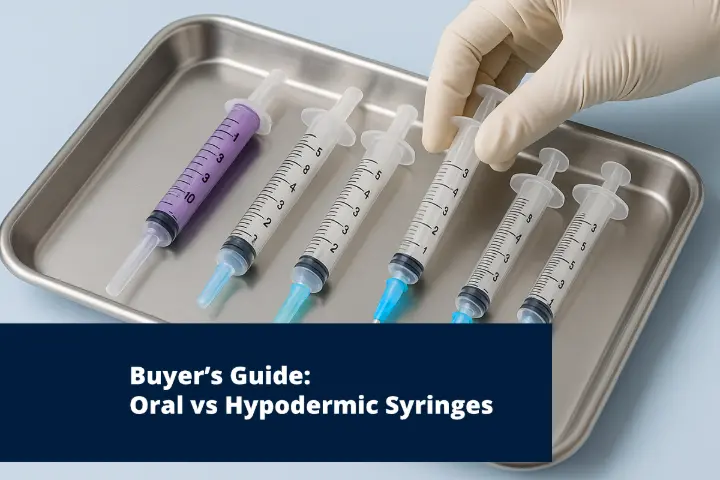Buyer’s Guide: Oral vs Hypodermic Syringes
Oral syringes and hypodermic syringes are in a similar product category, but they serve entirely different purposes. Understanding those differences isn’t just about compliance or inventory management. It’s about safety, patient outcomes, and making the right call when a clinician needs to trust the tools they are using.
There are not only key differences in clinical usage, but also in the standards, coding, and the manufacturing materials best suited to each category of syringe. Procurement teams need to assess these details carefully before placing an order.
The Role of Oral Syringes
Oral syringes are relatively simple clinical tools, but play a critical role in dosing accuracy, especially in pediatrics or geriatric care.
You’ve probably seen them in purple, sometimes amber. The color coding isn’t for aesthetics, it’s a safety measure and signals that this syringe is for oral use only. It should never be connected to a needle or IV line, a mistake that has happened in facilities without adequate safeguards or education.
Good oral syringes come with smooth plungers and the best ones have clearly printed, easy-to-read markings that don’t fade after being handled with gloves or wet hands. They’re usually BPA- and latex-free, sterile, and single-use. This criteria list is something procurement teams should be checking against when reviewing oral syringe product specifications.
There’s also the human element to consider: teaching nurses, caregivers and patients how to use oral syringes correctly. No one wants to assume that dosing liquid meds is intuitive - because that isn’t always the case. Comprehensive education and proper labeling reduce risks and improve compliance. That’s good medical practice and provides better care for patients.
Hypodermic Syringes: Where Precision Meets Protocol
Hypodermic syringes are found in injection trays, anesthesia kits, and vaccine carts. Designed to deliver medications or fluids directly into the body via injection, they must be reliable, versatile, and built to work with a range of needle gauges and lengths.
They come with a luer tip, either slip or lock - that connects securely to hypodermic needles. Those needles, in turn, vary by application: intramuscular, subcutaneous, intradermal. Having the right pairing of syringe and needle can reduce patient discomfort and improve clinical precision.
From a procurement standpoint, quality matters in ways that are sometimes hard to quantify in a spreadsheet. A poorly constructed hypodermic syringe increases the risk of leakage or injury. A dull needle creates pain. It’s not dramatic to say that tiny differences in bevel sharpness or plunger resistance can impact both patient experience and clinical outcomes.
It’s also worth noting that proper sharps disposal is non-negotiable. Whatever product you choose, pair it with training and infrastructure that makes disposal intuitive and safe. Otherwise, you’re opening up a risk profile that goes far beyond the point of injection.
Key Buyer Questions
Choosing between brands or models of syringes isn’t always about dramatic differences. Knowing the right questions to ask can help uncover subtle features that matter.
For oral syringes: Are the markings durable? Are the plungers easy to depress, even with small hands or weak grip strength? Are the sizes sufficient for dosing flexibility?
For hypodermic syringes: Do they pair well with your existing inventory of needles? Is the luer mechanism secure under pressure? Are they easy to use with gloves on?
Also, think through patient scenarios. A one-size-fits-all approach rarely works. Pediatric units, long-term care, ERs - they each need slightly different features, even for such seemingly basic tools.
Variety in inventory is often a key consideration. At MAP Medical we have a large catalog of oral and hypodermic products. There are around 40 product lines available in the oral syringe category and over 60 product lines in the hypodermic syringe category.
Quick Reference: Differences Between Oral and Hypodermic Syringes
Feature | Oral Syringe | Hypodermic Syringe |
Purpose | Administering oral medications | Injecting fluids into the body |
Tip | Often luer-slip tip | Typically luer tip or compatible with needles |
Color | Often purple or amber | Various colors, often clear |
Use with Needles | No needle required | Always used with needles |
Measurement | Precise measurement of liquid doses | Precise measurement of fluid volume for injection |
About MAP Medical
MAP Medical helps procurement teams find the supplies they need even when other distributors don’t have access to stock or can’t source hard to find items. With a product catalog featuring over 500,000 products from 3,000 manufacturers, MAP Medical supplies hospitals, acute care facilities, and educational & research labs with high quality products to match their exact requirements and budgets. Fast dispatch and delivery times, along with excellent customer service ensures the medical supply chain runs smoothly without interruption.
MAP Medical is more than just a supplier - we work as a strategic partner to enable every client that works with us to make tangible improvements in cost and time efficiencies. To find out more about how MAP Medical can help you, get in touch with our team today.



Buyer’s Guide: Oral vs Hypodermic Syringes